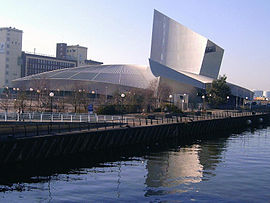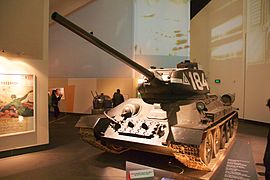
The Science Museum is a major museum on Exhibition Road in South Kensington, London. It was founded in 1857 and is one of the city's major tourist attractions, attracting 3.3 million visitors annually in 2019.

The Imperial War Museum (IWM), currently branded "Imperial War Museums", is a British national museum. It is headquartered in London, with five branches in England. Founded as the Imperial War Museum in 1917, it was intended to record the civil and military war effort and sacrifice of the United Kingdom and its Empire during the First World War. The museum's remit has since expanded to include all conflicts in which British or Commonwealth forces have been involved since 1914. As of 2012, the museum aims "to provide for, and to encourage, the study and understanding of the history of modern war and 'wartime experience'."

Daniel Libeskind is a Polish–American architect, artist, professor and set designer. Libeskind founded Studio Daniel Libeskind in 1989 with his wife, Nina, and is its principal design architect.

The Jewish Museum Berlin was opened in 2001 and is the largest Jewish museum in Europe. On 3,500 square metres of floor space, the museum presents the history of the Jews in Germany from the Middle Ages to the present day, with new focuses and new scenography. It consists of three buildings, two of which are new additions specifically built for the museum by architect Daniel Libeskind. German-Jewish history is documented in the collections, the library and the archive, and is reflected in the museum's program of events.

Salford Quays is an area of Salford, Greater Manchester, England, near the end of the Manchester Ship Canal. Previously the site of Manchester Docks, it faces Trafford across the canal.

Imperial War Museum Duxford is a branch of the Imperial War Museum near Duxford in Cambridgeshire, England. Britain's largest aviation museum, Duxford houses the museum's large exhibits, including nearly 200 aircraft, military vehicles, artillery and minor naval vessels in seven main exhibition buildings. The site also provides storage space for the museum's other collections of material such as film, photographs, documents, books and artefacts. The site accommodates several British Army regimental museums, including those of the Parachute Regiment and the Royal Anglian Regiment.

The National Army Museum is the British Army's central museum. It is located in the Chelsea district of central London, adjacent to the Royal Hospital Chelsea, the home of the "Chelsea Pensioners". The museum is a non-departmental public body. It is usually open to the public from 10:00 to 17:30, except on 25–26 December and 1 January. Admission is free.

The Lowry is a theatre and gallery complex at Salford Quays, Salford, Greater Manchester, England. It is named after the early 20th-century painter L. S. Lowry, known for his paintings of industrial scenes in North West England. The complex opened on 28 April 2000 and was officially opened on 12 October 2000 by Queen Elizabeth II.

Herbert Art Gallery & Museum is a museum, art gallery, records archive, learning centre, media studio and creative arts facility on Jordan Well, Coventry, England.

Trafford Park is an area of the Metropolitan Borough of Trafford, Greater Manchester, England, opposite Salford Quays on the southern side of the Manchester Ship Canal, 3.4 miles (5.5 km) southwest of Manchester city centre and 1.3 miles (2.1 km) north of Stretford. Until the late 19th century, it was the ancestral home of the Trafford family, who sold it to financier Ernest Terah Hooley in 1896. Occupying an area of 4.7 square miles (12 km2), it was the first planned industrial estate in the world, and remains the largest in Europe well over a century later.

The Bundeswehr Military History Museum is the military museum of the German Armed Forces, the Bundeswehr, and one of the major military history museums in Germany. It is located in a former military arsenal in the Albertstadt which is part of Dresden. After a long history of switching titles and approaches to military history, the museum was re-opened in 2011 with a new internal and external concept. The museum focuses on the human aspects of war, while also showcasing the evolution of German military technology.

The Culture of Manchester is notable artistically, architecturally, theatrically and musically. Despite being the 5th largest city in the United Kingdom by population and the second largest conurbation, Manchester has been ranked as the second city of the United Kingdom in numerous polls since the 2000s (decade), with an influential culture scene helping to elevate Manchester's importance in the national psyche. This has helped the city's population grow by 20% in the last decade, and made the universities the most popular choices for undergraduate admission.

The Royal Air Force Museum Midlands, located in Cosford in Shropshire, is a free museum dedicated to the history of aviation and the Royal Air Force in particular. The museum is part of the Royal Air Force Museum, a non-departmental public body sponsored by the Ministry of Defence and also a registered charity. The museum is spread over two sites in England; the other site is at the Royal Air Force Museum London at Colindale in north London.
The Art Treasures of Great Britain was an exhibition of fine art held in Manchester, England, from 5 May to 17 October 1857. It remains the largest art exhibition to be held in the UK, possibly in the world, with over 16,000 works on display. It attracted over 1.3 million visitors in the 142 days it was open, about four times the population of Manchester at that time, many of whom visited on organised railway excursions. Its selection and display of artworks had a formative influence on the public art collections that were then being established in the UK, such as the National Gallery, National Portrait Gallery and the Victoria and Albert Museum.

Imperial War Museum is a tram stop on the Manchester Metrolink's Trafford Park Line. It is located adjacent to Trafford Wharf Road and serves Imperial War Museum North. It opened on 22 March 2020.

Village is a tram stop on the Manchester Metrolink's Trafford Park Line. It is located adjacent to Village Way and is close to the Village Circle roundabout, its namesake. It opened on 22 March 2020.
Museum architecture has been of increasing importance over the centuries, especially more recently.
Frightful First World War was an exhibition that was held at the Imperial War Museum North from 24 May 2008 to 4 January 2009. It was based on the Horrible Histories book of the same name – one of the most popular of the series. It was produced in partnership with Terry Deary and Scholastic Children's books. The exhibition was free.
Maria Jane Balshaw CBE is director of the Tate art museums and galleries. The appointment was confirmed by Theresa May, the UK Prime Minister at the time, on 16 January 2017, making Balshaw the first female director of the Tate.

Nahem Shoa is a contemporary London painter best known for his series of portraits, collectively called Giant Heads, which were painted at up to 15 times life size. He is also notable for having increased the number of portraits of Black and mixed-race British people on display in British museums. Shoa has won a number of awards and prizes for his work, and serves on The Royal Albert Memorial Museum and Art Gallery's Contemporary Arts Panel. His work has been exhibited in London's National Portrait Gallery and the Royal Academy as well as at galleries and museums in other parts of the UK.




































